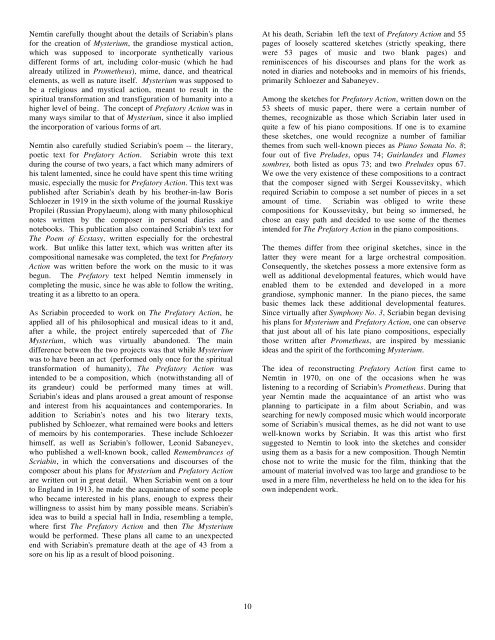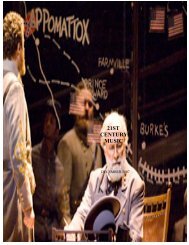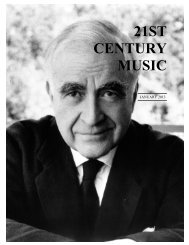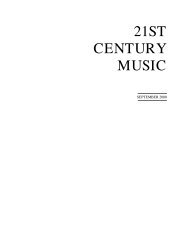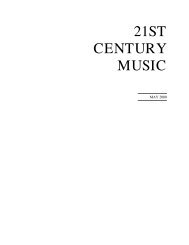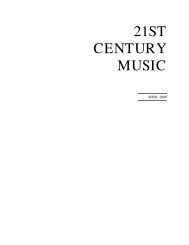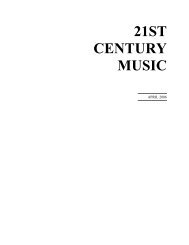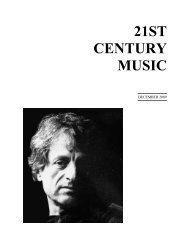Create successful ePaper yourself
Turn your PDF publications into a flip-book with our unique Google optimized e-Paper software.
Nemtin carefully thought about the details of Scriabin's plansfor the creation of Mysterium, the grandiose mystical action,which was supposed to incorporate synthetically variousdifferent forms of art, including color-music (which he hadalready utilized in Prometheus), mime, dance, and theatricalelements, as well as nature itself. Mysterium was supposed tobe a religious and mystical action, meant to result in thespiritual transformation and transfiguration of humanity into ahigher level of being. The concept of Prefatory Action was inmany ways similar to that of Mysterium, since it also impliedthe incorporation of various forms of art.Nemtin also carefully studied Scriabin's poem -- the literary,poetic text for Prefatory Action. Scriabin wrote this textduring the course of two years, a fact which many admirers ofhis talent lamented, since he could have spent this time writingmusic, especially the music for Prefatory Action. This text waspublished after Scriabin's death by his brother-in-law BorisSchloezer in 1919 in the sixth volume of the journal RusskiyePropilei (Russian Propylaeum), along with many philosophicalnotes written by the composer in personal diaries andnotebooks. This publication also contained Scriabin's text forThe Poem of Ecstasy, written especially for the orchestralwork. But unlike this latter text, which was written after itscompositional namesake was completed, the text for PrefatoryAction was written before the work on the music to it wasbegun. The Prefatory text helped Nemtin immensely incompleting the music, since he was able to follow the writing,treating it as a libretto to an opera.As Scriabin proceeded to work on The Prefatory Action, heapplied all of his philosophical and musical ideas to it and,after a while, the project entirely superceded that of TheMysterium, which was virtually abandoned. The maindifference between the two projects was that while Mysteriumwas to have been an act (performed only once for the spiritualtransformation of humanity), The Prefatory Action wasintended to be a composition, which (notwithstanding all ofits grandeur) could be performed many times at will.Scriabin's ideas and plans aroused a great amount of responseand interest from his acquaintances and contemporaries. Inaddition to Scriabin's notes and his two literary texts,published by Schloezer, what remained were books and lettersof memoirs by his contemporaries. These include Schloezerhimself, as well as Scriabin's follower, Leonid Sabaneyev,who published a well-known book, called Remembrances ofScriabin, in which the conversations and discourses of thecomposer about his plans for Mysterium and Prefatory Actionare written out in great detail. When Scriabin went on a tourto England in 1913, he made the acquaintance of some peoplewho became interested in his plans, enough to express theirwillingness to assist him by many possible means. Scriabin'sidea was to build a special hall in India, resembling a temple,where first The Prefatory Action and then The Mysteriumwould be performed. These plans all came to an unexpectedend with Scriabin's premature death at the age of 43 from asore on his lip as a result of blood poisoning.At his death, Scriabin left the text of Prefatory Action and 55pages of loosely scattered sketches (strictly speaking, therewere 53 pages of music and two blank pages) andreminiscences of his discourses and plans for the work asnoted in diaries and notebooks and in memoirs of his friends,primarily Schloezer and Sabaneyev.Among the sketches for Prefatory Action, written down on the53 sheets of music paper, there were a certain number ofthemes, recognizable as those which Scriabin later used inquite a few of his piano compositions. If one is to examinethese sketches, one would recognize a number of familiarthemes from such well-known pieces as Piano Sonata No. 8;four out of five Preludes, opus 74; Guirlandes and Flamessombres, both listed as opus 73; and two Preludes opus 67.We owe the very existence of these compositions to a contractthat the composer signed with Sergei Koussevitsky, whichrequired Scriabin to compose a set number of pieces in a setamount of time. Scriabin was obliged to write thesecompositions for Koussevitsky, but being so immersed, hechose an easy path and decided to use some of the themesintended for The Prefatory Action in the piano compositions.The themes differ from thee original sketches, since in thelatter they were meant for a large orchestral composition.Consequently, the sketches possess a more extensive form aswell as additional developmental features, which would haveenabled them to be extended and developed in a moregrandiose, symphonic manner. In the piano pieces, the samebasic themes lack these additional developmental features.Since virtually after Symphony No. 3, Scriabin began devisinghis plans for Mysterium and Prefatory Action, one can observethat just about all of his late piano compositions, especiallythose written after Prometheus, are inspired by messianicideas and the spirit of the forthcoming Mysterium.The idea of reconstructing Prefatory Action first came toNemtin in 1970, on one of the occasions when he waslistening to a recording of Scriabin's Prometheus. During thatyear Nemtin made the acquaintance of an artist who wasplanning to participate in a film about Scriabin, and wassearching for newly composed music which would incorporatesome of Scriabin's musical themes, as he did not want to usewell-known works by Scriabin. It was this artist who firstsuggested to Nemtin to look into the sketches and considerusing them as a basis for a new composition. Though Nemtinchose not to write the music for the film, thinking that theamount of material involved was too large and grandiose to beused in a mere film, nevertheless he held on to the idea for hisown independent work.10


